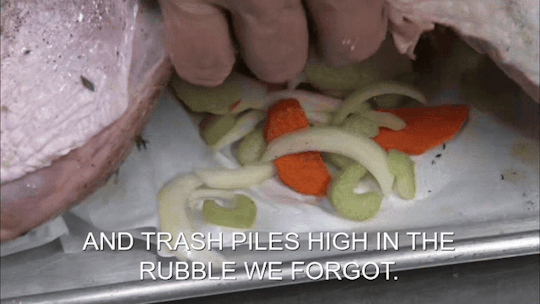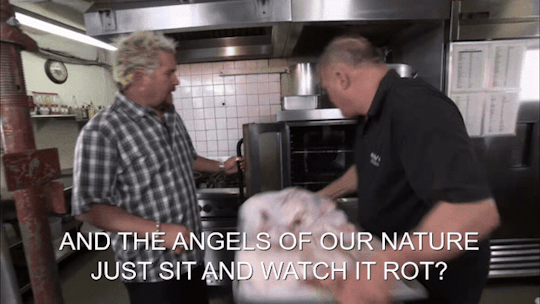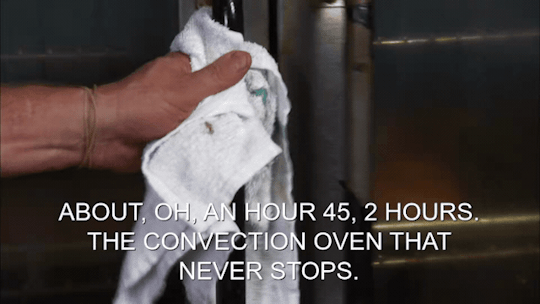#Convection
Explore tagged Tumblr posts
Text
Origins of Salt Polygons

Around the world, dry salt lakes are crisscrossed by thousands of meter-wide salt polygons. Although they resemble crack patterns, these structures are actually the result of convection occurring in the salty groundwater beneath the soil. (Image credit: S. Liu, see also: Physics Today) Read the full article
266 notes
·
View notes
Text
found this banger in my drafts

#what was i even talking about#april yaps#tumblr drafts#idk how to tag this#convection#conduction#radiation#convection conduction radiation#??#heat
5 notes
·
View notes
Note
Not an art request, but I was super curious about your elite force snow day drawing you did. Why is Kaz miserable in the back when he literally has fire powers to warm himself up?
So i'm kind of a nerd and I always try to look into the logistics of how the characters powers work. For Kaz it's similar to convection currents. I'll try to explain in simple terms but what he's experiencing by being even colder now that he has his powers is because cold is just the absence of heat.
Basically, when something is really hot, the hot wants to spread and travel to the not hot areas. Think like how a fire is able to keep a room warm without physically spreading around the room and setting everything ablaze. The heat travels through the air.
so to an outsider Kaz is super warm but to Kaz unless it's super hot in his environment he's going to feel cold because his natural body heat is leaving him to warm up his surroundings.
#mighty med#superpowers#lab rats elite force#kaz mm#kaz lref#mm kaz#lref kaz#science#convection#powers
8 notes
·
View notes
Text

The second mode of heat transfer is known as convection ( 2 ) ( 3 ), or the mass transfer of heat in a fluid. During convection, the heat moves away from the source, such as how hot air rises, or warm water can move to the top when cooking, due to the changing density of the fluid in question.
10 notes
·
View notes
Text
Does convection contribute to the volcanism experienced on planet Venus?
#volcanism#convection#planet venus#geology#volcanoes#venus#astrogeology#planetary science#venusian surface#space science#venusian volcanoes
3 notes
·
View notes
Text
candle convection 🕯
3 notes
·
View notes
Text





[NO. YOU BEEN DOIN' TIME WITH THYME? AND TRASH PILES HIGH IN THE RUBBLE WE FORGOT. AND THE ANGELS OF OUR NATURE JUST SIT AND WATCH IT ROT? ABOUT, OH, AN HOUR 45, 2 HOURS. THE CONVECTION OVEN THAT NEVER STOPS. THAT'S IT. NOW IT COMES OUT. YOU COOL IT DOWN.]
#s09e04 bringin' it home#guy fieri#guyfieri#diners drive-ins and dives#rubble we forgot#trash piles#nature just#an hour#no#time#thyme#the#angels#2 hours#convection
5 notes
·
View notes
Text
The Mysteries of the Sun. Part 1

image: credit to #NASA
Can there be order in chaos? Is it possible to poke a hole in the atmosphere? Can one part of a celestial body rotate at one speed while another part rotates at a different speed? These might seem like foolish questions, wouldn’t they? But it turns out they aren’t. Such fascinating phenomena are found not just anywhere, but right in our own neighborhood, near our star—the Sun.
You surely know that the Sun rotates around its axis, just like many other celestial bodies. Some rotate faster, others slower. Some spin very slowly. The Sun also rotates, but in a very peculiar way. The equatorial part of the Sun spins at one speed, while the polar regions spin at another. Let's note, for example, a point on the solar equator... Wait, how is this possible? The Sun is a giant boiling cauldron, its surface composed not even of hot gas, but of hot plasma. There is fiery chaos on the Sun. How can you stick a pole into it somewhere on the equator or at high latitudes to track when this pole disappears from view and when it comes back into view to determine the speed at which the Sun rotates around its axis? Where is that stable object, fixed in place, that you can observe to determine the rotation speed?

Image: credit to #NASA
The temperature of the Sun, like that of any star, is extremely high. It is believed that deep within the Sun, it reaches many millions of degrees Celsius, while on the surface it is only about 6000 degrees. However, in science, temperature is measured in Kelvin, and on this scale, the surface temperature of the Sun is also around 6000 degrees. The exact number isn't important here. What matters is that the temperature is so high that the gas atoms making up the Sun's atmosphere cannot remain intact and disintegrate into their components: electrons jump off their orbits, leaving the atomic nuclei to move separately.
Do you remember from your school courses the three main states of matter? The first is solid, where atoms are arranged in a lattice, standing in neat rows. The second is liquid, where atoms are heated and escape from the lattice, moving freely but still maintaining bonds with each other. The third is gaseous, where with even more heating, atoms completely lose their bonds and disperse as a gas. Plasma is the fourth state of matter, where with further heating, the atoms themselves disintegrate into their constituent parts: atomic nuclei, which have a positive charge, now fly separately from their electrons, which are negatively charged. So, we have not just a gas, but a charged gas that responds to electric and magnetic fields.

Image: credit to #firefly.adobe
So, the Sun is extremely hot. It’s like a large boiling pot, heated from below by a burner reaching several million degrees. You might think that at such temperatures, the Sun would be a scene of complete chaos and nothing else! But no — even in the most bubbling, boiling pot, there is an internal order, strange as it may sound. Boiling, despite all its apparent chaos, is not entirely chaotic. This was noticed by a scientist who began observing oil in a hot frying pan. He saw that even with perfectly even heating, the hotter and thus lighter oil in some places rises from the depths to the surface, where it spreads out and cools, while in other places, the cooler and thus heavier oil sinks downward. This creates stable convection structures that were named Bénard cells after the scientist. Another name for them is Rayleigh-Bénard cells, including the name of another scientist who also studied processes in heated mediums. And this is what it looks like:

Image: Credit to https://instructional-resources.physics.uiowa.edu
The process of heating and cooling in the Sun's atmosphere, as well as in other stars, follows a similar pattern. In the Sun's upper atmosphere, this phenomenon closely resembles the behavior of Bénard cells. These temperature-exchange cells can vary in size, and within the Sun and other stars, large-scale heat exchange is organized into even bigger cells, encompassing massive, complex processes.

Image: Credit to https://physicsworld.com
The heated masses from the Sun's interior flow from the poles toward the equator, where they rise to the surface. Once at the surface, these masses flow toward the poles, cooling as they travel. In the polar regions, the cooled solar plasma begins to sink back toward the Sun's core, completing the cycle as it flows back toward the equator.

Credit: Mystery of solar cycle illuminated
This process is not unique to stars—it also occurs in Earth's oceans, where water heated at lower latitudes is carried by currents to cooler regions, creating stable flows. Similarly, within the Earth, hot magma follows comparable patterns, gradually driving the movement of continents. Wherever there is a heat source on one side and cooling on the other, these processes emerge. Even in a simple room with a heater, air forms currents that circulate along specific paths. Warm air rises as it heats, then sinks as it cools, naturally forming stable currents, provided there are no significant obstacles to disrupt the flow. This process is called convection. In the case of large masses of air, water, or other media moving in a horizontal plane, it is called advection. Here, we are not dealing with small (comparatively) cells where heat exchange occurs, but with global flows comparable in scale to the size of a planet or a star.
And how all these processes manifest on the Sun will be explained in the next talk. Stay tuned!
6 notes
·
View notes
Text
this is what I mean when I say I’m busy

#my fear of seeming inattentive and lazy to my friends haunts me every day#/silly#CONVECTION#RADIATION!!!!#EVAPORATION!!!!!!!!!!!!!!!!!#CONDUCTION!!!!!!!!!!!!!!!!!!!!!!!!!!!!!!!!!!!!!!!!!!
11K notes
·
View notes
Text

1 note
·
View note
Text
Salt Fingers

Any time a fluid under gravity has areas of differing density, it convects. We're used to thinking of this in terms of temperature -- "hot air rises" -- but temperature isn't the only source of convection. (Video and image credit: M. Mohaghar et al.) Read the full article
#2024gofm#convection#double diffusive convection#double diffusive instability#flow visualization#fluid dynamics#oceanography#physics#science
83 notes
·
View notes
Text
#1286 What is the difference between conduction, convection, and radiation?


What is the difference between conduction, convection, and radiation? The difference is that they are three different ways of transferring heat energy. I think we first need to look at what heat is. Heat is defined as “the transfer of thermal energy from one physical system to another system, or from one region in a physical system to another region”. Heat is form of energy, known as thermal energy. Unless it is stored in some way, heat is always in transit between areas of high heat and areas of low heat. This is all because of the second law of thermodynamics, which is the rule of entropy. Systems always become more disordered because statistically there are far more ways a disordered system can exist than there are ways an ordered system can exist. This applies to heat as well. Heat will always move from a hot object to a cold object. Put a hot cup of coffee on the table and the heat energy will move to the air, equalizing the temperature. Put a cold glass of ice coffee on the table and the heat will move from the air into the glass, equalizing the temperature. This is because atoms don’t want to have more energy than they are supposed to and if they have extra energy in the form of thermal energy, they want to get rid of it as quickly as possible. Thermal energy is a form of kinetic energy and it refers to how much the molecules within a substance are moving. The more heat they have, the more they move. Energy has to go into the system to make them move. Once there is no more energy going into the system, they want to return to their original state and they release the energy, slowing down. The molecules in the coffee cup release their energy to the air and the coffee cup molecules slow down and the air molecules slightly speed up, until they are all moving at the same speed, or at the same temperature. There are three ways that an object can lose its heat energy and those are conduction, convection, and radiation. Conduction is probably the form of heat transfer we are most familiar with and it involves heat transfer through touch. The objects undergoing the heat transfer have to be solid or a fluid that is stationary. When we heat an object, we supply it with energy and the molecules start to move faster, giving them more kinetic energy. If these high energy molecules come into contact with the molecules of another object, they can pass their energy across to those other molecules. By doing this, the molecules of the first object lose their thermal energy and the objects of the second object gain thermal energy. This happens until the two are equal. You can imagine it as holding a frying pan with a metal handle. As you supply energy from your gas hob, the molecules in the frying pan start to move more. If you touch the metal handle with your hand, the moving molecules in the frying pan will excite the molecules in your hand, giving them more energy and giving you a nasty burn. This is conduction. Convection is a form of heat transfer in a fluid. It is where heat energy is moved from a high energy part of the fluid to a low energy part of the fluid. The high energy moves to the low energy, and the two equalize. This happens until all of the heat energy in the fluid is the same. A good example of this is a bath. If you are in the bath and the temperature is getting cold, you switch the hot tap on. You can feel the hot water by your feet, so you use your hands to stir the water. The high energy water by the tap moves to the low energy area by your upper body and imparts its energy. If you continue imputing energy from the tap, you can keep convecting the thermal energy until the whole bath is the same temperature. The last type of heat transfer is radiation. Radiation is when the heat is transferred by electromagnetic waves that are produced by the heat. When the molecules in an object move because of the heat energy supplied to them, they collide with other particles. Every time they hit another particle, their kinetic energy is slightly reduced and this difference in energy is released as heat radiation. It is infrared radiation. This electromagnetic wave can travel and transfer that heat energy to something else. When you are in a bath and the water is going cold, that is because of conduction, convection, and radiation. The heat is being conducted out of the water into the surrounding bathtub, the air, and your body. The heat is being convected out as currents swirl in the bath and bring the warm water to the top. And the heat is being radiated out as well. And this is what I learned today. - #680 How does insulation in the home work? - #1215 How do bone conduction headphones work? - #367 Why are steam burns worse than boiling water burns? - #1130 Why can warm air carry more moisture? - #1065 What is a superconductor? Sources https://testbook.com/physics/difference-between-conduction-convection-and-radiation https://byjus.com/physics/difference-between-conduction-convection-and-radiation https://www.techtarget.com/whatis/definition/heat https://en.wikipedia.org/wiki/Heat https://byjus.com/physics/heat-transfer-thermal-radiation Photo by Anastasia Shuraeva: https://www.pexels.com/photo/coffee-cup-and-glasses-on-a-table-4100824/ Read the full article
0 notes
Text
i think i may get an A on my physics exam like, i think i did all the required stuff according to the marking guide + some more shit i added though i did start rambling about the musical alphabet at the end "the musical alphabet ends at G and then goes back to A" bitch what are you on about?? you're learning convection, conduction and radiation - now do your fucking vacuum seal question and calculate the efficiency of a ceiling fan IT'S WORTH MOST OF YOUR FUCKING GRADE AND THERES 4 MINUTES LEFT!!??!!? but yeah i think i did well
#school#exams#grades#student#highschool#mathematics#physics#science#radiation#convection#conduction#special ed#extra time on exams
1 note
·
View note
Text
Having greater density than the air above, it does not rise and there is little convective mixing.
"Environmental Chemistry: A Global Perspective", 4e - Gary W. VanLoon & Stephen J. Duffy
#book quote#environmental chemistry#nonfiction#textbook#density#climate#smog#photochemical smog#convection
1 note
·
View note
Text
#best college of engineering in trichy#best autonomous college of engineering in trichy#krce the top engineering college in trichy#top college of engineering in trichy#PrinciplesofThermodynamics#ApplicationsofThermodynamicsandHeat Transfer#Thermodynamics#HeatTransfer#EnergyTransformation#Conduction#Convection#EngineeringApplications#ThermalAnalysis
0 notes
Text
hA🔺t
Numeric etching / Briat 2014 – – – – Le journal du peintre Les tableaux du peintre Instagram Mastodon – – – – Le journal du peintre Les tableaux du peintre Instagram Mastodon – – – – Le journal du peintre Les tableaux du peintre Instagram Mastodon – – – –

View On WordPress
0 notes